Pennsylvania funding for farmland exceeds last year’s
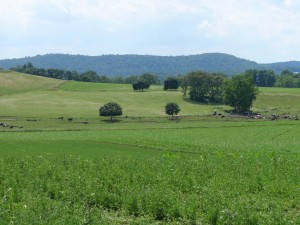
Lebanon County farm (FPR photo)
HARRISBURG, PA – Pennsylvania will have $22 million to spend on farmland preservation in the coming year, $2 million more than last year, and some counties will benefit more than others by virtue of their commitments to spend more themselves. Lancaster County comes out on top, a place it is used to holding. With the most acres preserved, it also put up the most local money to spend, and therefore reaps more funding from the state coffer – this year, $2.3 million, more than any other county and about $400,000 more than last year.
Other counties with significant cash for the upcoming year include Bucks, which appropriated $2.5 million and was awarded $1.9; Northampton, which appropriated $3.7 million and received $1.8 million; and Berks which appropriated $1 million and received $1.4 million. Chester County, where local funding has been hit, put up $659,000 and pulled $1.3 million from the state.
Under the formula the state program uses to match county dollars, half of a county’s funding score comes from how much it appropriates relative to other counties. The other half of the formula grades the level of property tax revenues a county generates. This explains why Montgomery County, a populous and desirable Philadelphia suburb, can appropriate just $270,280 to save its hard hit and expensive remaining farm acres but receive $1 million from the state in aid, and similarly, Chester County receives twice as much as it puts in.
Tom Daniels, professor of planning at the University of Pennsylvania and former administrator of the Lancaster County program, has criticized the Pennsylvania funding formula for funneling high dollar amounts to urbanizing counties like Montgomery, where agriculture is not a high value industry. According to Daniels, preserving farmland in such counties is open space preservation and has little to do with agriculture.
In 2008 an audit conducted by the Legislative Budget & Finance Committee, a joint committee of the legislature, reviewed 19 issues surrounding farmland preservation. One of the areas examine was the cost of easements in areas with high development pressure. The report authors stated they found “widespread support for the State Board to reduce the program’s emphasis on preserving high-cost farms in the path of development, which would allow more acreage to be preserved on better-value farms that, in the long run, are likely to prove more beneficial to a county’s agricultural industry.”
Officials in Montgomery County disagreed with that assessment, reporting that high-value production in proximity to high-density population offsets the cost of such easements are are vital to that county’s agricultural industry.
A cap of $10,000 per acre was removed from the program in 2001. As of the end of 2007, according to the audit, the state had contributed funds to 36 projects totaling 2,613 acres costing over $10,000 per acre and a total of $38.3 million. The report stated that those funds would have purchased 23,759 acres using the state’s average per acre cost of $1,612 for easements costing less than $10,000.
Regardless of land use circumstances in urbanizing localities, the state formula sends most state preservation dollars to the southeastern quadrant of the state, which as a whole has the state’s best soils and highest value ag production.
Did I get into this business just to fight alligators?

Mike McGrath
BY MIKE MCGRATH, Contributing Editor
“When you’re up to your ass in alligators, it is difficult to remember your original mission was to drain the swamp.”
Do you remember your original mission in farmland preservation? It was to save farmland, right? Your objective was to permanently preserve as much of the good farmland, as quick as you could. That’s pretty straightforward isn’t it? We all got enthused about that objective and the citizens – the taxpayers in your jurisdiction – they were fired up, too. Then things got a little messier – the Federal government wanted to help us preserve America’s farms. And why not? Something so popular would be embraced by Congress, of course. Mark Twain once quipped something to the effect, “The essence of politics is to find a parade and jump in front of it!” There was a parade forming behind farmland preservation and there were plenty of political leaders willing to be the drum major! But then there’s the Federal bureaucracy!
Ronald Reagan once said, “The nine most terrifying words in the English language are: ‘’I’m from the government and I’m here to help.’” For an actor he was pretty insightful and he would have loved to use the FRPP as an example – if he was still around. At the recently concluded roundtable conference of farmland preservation managers convened by FPR publisher Deborah Bowers in Annapolis, Md. earlier this month, I was again reminded that the swamp is full of alligators – and many are from USDA! I must note that when Bill Clinton first cooked up the idea of funding farmland preservation life was much simpler.
Do any of you remember those days? We got word that there was excess money in the CCC (Commodity Credit Corporation) and that the president had decided to spend some of it to preserve farmland. You just had to request the money, show how you spent it and a check arrived! I had never seen such a simple, easy, straightforward Federal program in my life (and I had been involved with HUD grants, and others, for years). It worked! We preserved many acres in a short time. We were ecstatic – the Feds were ecstatic – Congress was ecstatic – local politicians were ecstatic. Well, the USDA lawyers weren’t so ecstatic! This was just too easy – just too undefined – just too subject to fraud (really?) – in short, we needed new rules and a new bureaucracy! Here come the alligators!
At the Annapolis conference we heard from the outgoing administrator of FRPP and there’s some good news – some of the alligators may be removed. Not all, but some! There may be fewer obstacles in the path of established programs that want to use Federal funds to preserve farmland. Now, that’s good news! But, as I sat and listened to the presentation on FRPP changes, and the questions, and the concerns, I got worried about something else – we may be tempted to forget “. . . our original mission was to drain the swamp.” And this, in my opinion, is a serious danger.
As program administrators and professionals working to preserve farms from development, we must never forget why we do what we do. We must resist the real temptation to get caught up in the processes, rules, regs – the bureaucracy – of what we do. Don’t misunderstand me – we must follow the rules, play the games, and abide by laws that govern what we do. That’s a given. They are the means to the end. But the means can consume us and obscure the goals that create the passion and the excitement. Let’s never lose sight of our ultimate mission – saving America’s farms! At times we will need to sharpen our focus on the things that really matter in this business. Let me suggest some concrete steps you can take to stay focused on what matters.
Why not make a list of goals for your program in concrete terms of acres, farms and dollars for the coming year. Then flesh out what steps you will need to take to achieve those numbers. Be realistic, but think big. Talk to the staff you work with about what needs to get done. Encourage the positive attitudes that come from focusing on the good results that have been achieved. Why not do a survey of citizens in your community to measure the support for farmland preservation – you will be pleasantly surprised at the positive energy – and so will the political leaders in your jurisdiction! Write a letter to the editor about the results of farmland preservation and all the positive benefits that have accrued to the community. Don’t sound needy – just let people know about the positive energy and the results.
Whatever we do we can’t allow the toil of details to sap all our energy. We must rise above the level of those who only see regulations and processes and limitations – and spend more time talking to those who see the possibilities and the promise of the future. All of us in this business of preserving our nation’s farms and forests must spend time to maintain our energy to “drain the swamp.” We can’t wear ourselves out with fighting the alligators!
Mike McGrath is the fearless leader of the Delaware Agricultural Lands Preservation Foundation and an FPR contributing editor. He can be reached at mhmcgrath@gmail.com.
Michigan could terminate property tax relief program for farmers
BY DEBORAH BOWERS, Editor & Publisher

MI Gov. Rick Snyder (Associated Press)
LANSING, MI – Michigan Gov. Rick Snyder’s proposed budget would eliminate a number of tax credits and incentives, including the Farmland & Open Space Preservation Tax Credit, also known as Public Act 116. The program is Michigan’s property tax relief for farmers and gives credits based on income in exchange for a 10-year land use restriction.
But the governor’s proposal can’t easily do away with a taxing principle that every state in the nation employs, that is, that farm land, in farm use, should be taxed on its current use not its highest and best use as defined in local law. According to the governor’s office, the plan is to keep all current contracts but to phase out new ones.
So Michigan farmers are waiting for the other shoe to drop, in the form of legislation that will provide an alternative to the income tax credit they’ve been claiming for decades. The credit is equal to the amount of property taxes exceeding 3.5 percent of the household income and is applied to both land and improvements covered by an agreement.
“We’re still waiting for a number of details to be worked out,” said Rebecca Park, a lobbyist with Michigan Farm Bureau and expert in tax law. “But the initial thought is that if farmers want to renew or extend their P.A. 116 contracts, they can do that all the way out to the 90- year limit. But they have to apply by the end of 2011.” Park warned that farmers wanting to extend their credits should do it soon “to allow time for paperwork to be processed.”
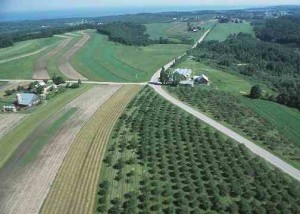
Grand Traverse Co MI orchard (Photo by NRCS)
Lands enrolled in P.A. 116, in addition to the income tax credit, avoid special assessments for sewer, water, and other non-farm projects, something that could be continued even if the tax credit is phased out, according program administrator Rich Harlow of the Michigan Department of Agriculture.
But the tax credit is also tied to the purchase of development rights program in Michigan, another program Harlow manages. Rollback taxes that are collected when preservation tax credit contracts are not renewed fund the PDR program. If the credit is legislated away, then funding farmland preservation may also be revisited.
According to Harlow, the proposal to eliminate the tax credit is part of a budget restructuring underway.
“I believe the desire is to eliminate tax credits as an approach to dealing with a number of property tax issues, one of which is the farmland preservation program. Tax credits are largely invisible during the appropriation process. I believe the attempt is to cause the issuance of tax benefits to come before a review in appropriations. Although it is early to tell, perhaps another farmland preservation vehicle will be created that reduces the tax burden on farmers in Michigan but does so via the appropriation process.”

Allegan Co. MI flower crop (Photo by NRCS)
Some Michigan lawmakers may experience déjà vu if they approach the tax credit question. Eleven years ago the legislature scuttled an opportunity to establish traditional use-value assessment, in use for more than 40 years in most states as the method of choice to tax farmland fairly. The method values farmland based on its current use rather than on its speculative or market value. Instead, Michigan’s credit is a “circuit breaker” form of tax relief, which caps the percentage of income a farm household will pay in property tax.
Not only did the legislature in 2000 throw away a well-developed plan to upgrade its farmland taxation, it also turned its back on a proposed increase in and restructuring of the state’s rollback tax on cancelled tax credit contracts that would have gone much farther in funding the state’s purchase of development rights program, which has never seen meaningful or consistent funding.
Since the P.A. 116 credit was first established, 350 to 400 farmers have enrolled properties, on average, each year. As of Feb. 26 of this year, 40,628 active agreements were in place, protecting 3.1 million acres.
A study completed in 2006 by the Michigan State University Land Policy Institute completely skirted the rollback tax and found the most promising funding route for farmland preservation in Michigan was to expand the income tax, sales and use tax, real estate transfer tax, or gas tax. Also, it was suggested the legislature could dedicate all or portions of the bio-fuel tax revenue, implement a water tax, add a road toll, establish a sales tax on services, or levy impervious surface fees as possible ways to pay for farmland preservation.
Wisconsin governor wants to kill fledgling farmland program
BY DEBORAH BOWERS, Editor and Publisher
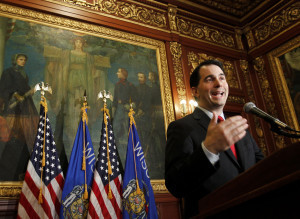
- WI Gov. Scott Walker’s massive budget cuts include eliminating the state’s new farmland preservation program
MADISON, WI – Wisconsin Gov. Scott Walker’s proposed biennial budget would eliminate the fledgling Working Lands Program, the only Northeast style, state level purchase of agricultural conservation easement (PACE) program to gain a foothold west of Ohio in the last decade. The program, complete with statewide planning requirements and funding for the PACE component through land conversion fees, was the brainchild of former state agriculture secretary Rod Nilsestuen who died last year. The program in its entirety is targeted for dismantling.
In addition, separate identical bills introduced this session (SB 24 and AB 34) would eliminate the PACE program and the conversion fee.
The Working Lands Initiative was approved in the budget of Walker’s predecessor Gov. Jim Doyle in 2009. If the elimination takes place, 16 approved applicants to the program will be left without contracts. The program was slated for $12 million in initial funding.
Board members of the Wisconsin Department of Agriculture, Trade & Consumer Protection approved a resolution during its board meeting this month that opposes Walker’s eliminating the program and the conversion fee, collected when land in a farmland preservation zoning district is rezoned for nonagricultural use.
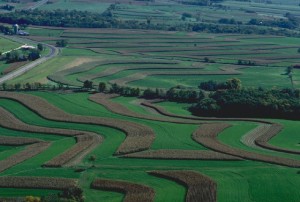
- Wisconsin farmland will lack protection if Gov. Walker’s plan is passed. View of Green Co., WI farmland (Photo by Ron Nichols, USDA-NRCS)
“The PACE program is an effective tool that works in tandem with local planning, to protect prime farmland, while allowing development in areas where it is appropriate,” the resolution stated. “In its first two years, PACE has received 75 applicants, protecting farmland on over 18,600 acres. Many landowners (and their respective cooperating entity–the town, county or land trust) whose 2010 PACE applications were preliminarily approved are pending incurred considerable legal, staff, and other expenses,” the resolution said.
The Wisconsin Farmers Union also is opposing the governor’s plan.
“Many people from all political spectrums worked to develop those programs as ways to assure that agricultural and woodlands would be available to future generations,” said Wisconsin Farmers Union president Darin Von Ruden said in a release. “The governor’s proposals only would make developers and speculators the winners where our valuable working lands are concerned.”
The Wisconsin Farm Bureau Federation is to date unopposed to the elimination of the farmland program and said in a position statement that it supported the governor’s austerity measures.
Some farmland preservation efforts at the local level in Wisconsin will remain at work if the program cut comes to pass. Rock County took up the Working Lands Initiative in earnest. Located on the state’s southern boundary, Rock County approved its PACE program in January and this month, the county board passed a resolution opposing the governor’s plan to kill the state PACE program. The county has $750,000 committed to its PACE program and expects federal matching funds as well. The county PACE board approved six applications last month that will protect 1,050 acres in three townships.
What the 2010 U.S. Census means for farmland preservation
BY TOM DANIELS, Senior Contributing Editor
The 2010 U.S. Census is now available on-line at www.census.gov. The big number is the national population—308,745,538—an increase of more than 27 million people and 9.7 percent from 2000. More mouths to feed means a greater need to retain farmland. Keep in mind that the United States is the fastest growing industrial nation, and is on track to reach 440 million people by 2050.
Farmland preservation efforts are most often measured at the county level. First, let’s look at the population change from 2000 to 2010 in the top 12 counties in farmland acres preserved in 2010 as reported in the September 2010 issue of Farmland Preservation Report (see Figure 1).
|
Figure 1. Population Change 2000 to 2010 in the Top 12 Counties in Farmland Acres Preserved |
|||
| COUNTY | 2000 POPULATION | 2010 POPULATION | PERCENT CHANGE |
| Lancaster, PA |
470,658 |
519,445 |
10.4 |
| Montgomery, MD |
873,341 |
971,777 |
11.3
|
| Berks, PA |
373,638 |
411,442 |
10.1 |
| Carroll, MD |
150,897 |
167,134 |
10.8
|
| Chester, PA |
433,501 |
498,886 |
15.1 |
| Baltimore, MD |
754,292 |
805,029 |
6.7 |
| Burlington, NJ |
423,394 |
448,734 |
6.0
|
| York, PA |
381,751 |
434,972 |
13.9 |
| Harford, MD |
218,590 |
244,826 |
12.0
|
| Frederick, MD |
195,277 |
233,385 |
19.5
|
| Marin, CA |
247,289 |
252,409 |
2.0 |
| Sonoma, CA |
458,614 |
483,878 |
5.5
|
Sources: Farmland Preservation Report (county ranking based on acres preserved); U.S. Census Bureau
Eight of the top 12 counties grew faster than the national rate of 9.7 percent. Frederick County, MD in greater Washington, D.C., and York County, PA, an affordable housing haven in the greater Baltimore region were the fastest growing counties. No county lost population, though Marin was nearly flat. All 12 counties are metropolitan counties in terms of their population. The bottom line is that the farmland resources in these top 12 counties continue to be under significant development pressure.
The top 12 counties are highly concentrated in Maryland and Pennsylvania.
Next, let’s look at the population changes in six other counties from around the nation (see Figure 2). Addison County, Vermont is that state’s leading agricultural county and has more than 50,000 acres preserved through the state’s Housing and Conservation Board and the Vermont Land Trust. (It has no locally operated program and so doesn’t qualify for FPR’s annual top counties survey).
Clark County, Ohio has preserved just over 10,000 acres, which puts it first among counties in the Midwest for farmland acres preserved. Fayette County, Kentucky is in the Bluegrass Country famous for its horse farms. The county has preserved about 25,000 acres. Fresno County in the heart of California’s Central Valley is the nation’s leading agricultural county with more than $3 billion a year in the sale of farm products. Kane County, just west of Chicago, is the top county in farmland preservation in Illinois; it is the only county with a PDR program. Sussex County, Delaware produces more than $400 million a year in farm products, and in the Northeast, is second only to Lancaster County, PA.
Figure 2. Population Change 2000 to 2010 in Six Other Counties.
County 2000 Population 2010 Population Percent Change
Addison, VT
35,974
36,821
2.4
Clark, OH
144,742
138,833
-4.1
Fayette, KY
260,512
295,803
13.5
Fresno, CA
799,407
930,450
16.4
Kane, IL
404,119
515,269
27.5
Sussex, DE
156,638
197,145
25.9
Source: U.S. Census Bureau
Four of these six counties grew faster than the United States as a whole from 2000 to 2010.
Kane and Sussex Counties added population by more than twice the national rate.
Perhaps most alarming is the strong population increase in Fresno County, the nation’s agricultural gem, and the number one producer in California with 5.3 billion in ag production in 2009. Farmers in Fresno grow more than 200 types of crops, some of which are not grown in other parts of the United States. But county land use law grew its own crop over the decade: an increase of 131,000 people.
Population growth in Addison County, Vermont was essentially flat and Clark County even lost population. Clark’s situation is fairly common in the Midwest. For instance, two-thirds of the counties in Iowa—the nation’s number two farm state—saw population declines in 2000-2010.
So, there remains plenty of farmland in the Heartland, but on the East and West Coasts, the pressure to retain farmland continues.
Tom Daniels is senior contributing editor to FPR.
Allowed uses on preserved farms hot topic at farmland preservation roundtable
BY DEBORAH BOWERS, Editor & Publisher
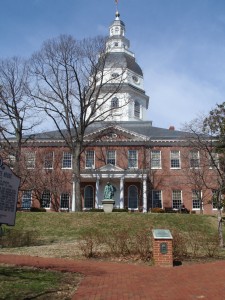
Maryland lawmakers were meeting at the State House while farmland preservation administators met across the street at the historic Gov. Calvert House
ANNAPOLIS, MD – Some of the nation’s top farmland preservation administrators met in Annapolis, Md., March 14-15 to discuss the future of protecting farmland and the difficult issues that are cropping up as state governments pursue energy production and struggle to resolve deficits. The 4th Farmland Preservation Roundtable, an invitational event presented by Farmland Preservation Report and moderated by FPR publisher Deborah Bowers, brought together 24 state and county-level farmland preservation program directors and a number of farmland-focused land trusts from 10 states.
The group heard from Farm and Ranchland Protection Program (FRPP) administrator Mark Rose of USDA-NRCS, on his last day in that position, about changes to the program. Rose reviewed those changes and answered many questions from administrators who have had difficulty meeting the program requirements. Some administrators learned the ins and outs in the definition of pending offers and how differences in state-level procedures might be addressed. Rose told Maryland participant Carol West that she would have to convince NRCS that a landowner’s asking price in Maryland’s bidding system is a pending offer. Rose suggested a rewrite of Maryland’s landowner application could improve a pending offer confirmation.
Susan Payne, executive director of the NJ State Agriculture Development Committee asked how the NRCS would view eligibility of farms with wind turbines and other energy production development, now allowed under NJ law.
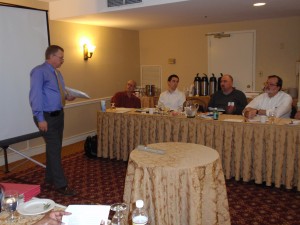
FRPP program manager Mark Rose of USDA-NRCS explains the program's final rule
“We’re going to look at the impact on the easement,” Rose said. “Sometime in the future it will have to be addressed.” NJ law restricts wind energy on preserved farms to serving the farm’s energy needs as the primary use. Rose indicated NRCS would support the “primary use” language because “otherwise we would have to measure output.”
Several program directors complained to Rose that federal appraisal review was taking too long.
Effective the day he spoke to the group, Rose became program manager of the Environmental Quality Incentives Program (EQIP) at USDA.

Pa. program director Doug Wolfgang, Ray Pickering, Fauquier Co. Va.; Susan Payne, NJ SADC, and FPR publisher Deborah Bowers
Doug Wolfgang, program director from Pennsylvania, presented his department’s new online system for county programs to input project information, and for state board members to retrieve board packets – a huge savings in staff time prior to state board meetings, he said. Delaware has also automated various aspects of data collection, including monitoring, said director Mike McGrath. McGrath said a camera connected to a GPS enables his division to monitor 880 farms in four months, including federal and state easements as well as agricultural districts. A title search is conducted on a certain percentage of farms each year, he said, to check for changes in ownership.
Allowed uses on preserved farms a hot topic
In a session called “That’s a Stretch,” administrators shared their challenges in dealing with how legislatures are changing the definition of agriculture as well as changing policy on what kind of uses are allowed on preserved farms. McGrath said the Delaware legislature considered allowing paintball, water slides, and even ATV race tracks in the definition of agricultural use. Paintball was approved, “so enabling statute in Delaware [for agriculture] includes paintball, and so by definition, it is allowed on preserved farms,” he said. McGrath said the real issue that he sees is that the general public in all likelihood would say paintball is not agriculture. “All the public goodwill toward farming does not include paintball,” he said.
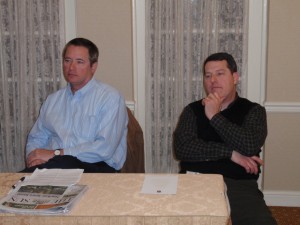
Bill Amoss, left, Harford County, Md. and Jeff Everett, Carroll County, Md., manage two of the nation's most successful local programs
Ellen Dayhoff, administrator for the Adams County, Pa. farmland program said her measure of the appropriateness of an allowed use is, “does it hurt the economic viability of the farmland tract?”
Susan Payne of the NJ SADC said the problem in New Jersey is that “farmers are beating the drum that anything that makes money for them is good for agriculture. But is it good for the public? I get tired of defending agricultural production when the farming community doesn’t say ‘that isn’t agriculture.’ So the debate is, what does keeping land for agriculture mean? We’re in a struggle to define our soul for the next 25 years.”
Several administrators said flexibility was important as a means to pump up farm income and keep farms viable. Brian Wilson of Burlington County, NJ, said allowed uses could simply be a matter of scale. “How do you legislate scale? A couple of weekends with a tent or paintball?”
In Pennsylvania, each county “has boilerplate language for accessory enterprises,” said Doug Wolfgang. The allowable area may be the house and curtilage. In Pa., counties, not the state, regulate accessory uses. Lancaster County’s Matt Knepper said his program sees accessory uses as a means to enable farmers to earn more income and stay on their farms.

Brian Wilson, Burlington Co. NJ; Nancy Everhart, Vermont; Nina Young, Maine Farmland Trust; Bill Amoss; Jeff Everett
Some administrators said historic preservation policy, particularly for old barns, had become a difficult issue for farmers because of the cost involved, and this was running headlong into the issue of defining agricultural production, because of the types of events and uses that are a natural fit to old structures.
Bob Wagner of American Farmland Trust said he didn’t think it is a problem if one dy a farm buiding is used for a non-ag function.
“If you look at the statute it was about protecting land for future agricultural use. It didn’t say anything about building use, and the land is still there.”
Bill Amoss of Harford County, Md., said one of his chief concerns was wetland and forest mitigation on preserved farms that has been allowed and even encourage by the Maryland state program since the 1990s. In many cases, good farmland is being taken out of production and owners are being paid by developers and mitigation companies to create wetlands and forested areas. “It’s really getting out of hand,” he said. Amoss said the TMDL goals for the Chesapeake Bay set by EPA would likely lead to further conversion of agricultural land for environmental purposes. He indicated TMDL money was a possible source for funding purchase of development rights.

Roundtable moderator Deborah Bowers shares a laugh with NJ SADC executive director Susan Payne
Susan Payne said taking land out of production for environmental mitigation was a “serious question” that could be in conflict with ag preservation policy or law. “The time is now to draw these lines.”
Amanda Behrens of the Johns Hopkins Center for a Livable Future showed the group her findings on the lack of fresh and locally grown foods in the City of Baltimore. Behrens has been compiling data on food production in Maryland and what neighborhoods have access to quality food, including local foods. She found that the inner city had food stores, but they offered low quality foods, while neighborhoods toward the fringes of the city had superior access to local and gourmet foods. Farmland program administrators said food availability had become an issue because the land base that is the result of decades of farmland preservation is becoming the land that will feed the surrounding metropolises.
Susan Payne said farmers markets in New Jersey are looking for farmers. “What are we going to do? We have a retreat this month to try to fill the void.” Putting ag marketing into ag preservation programs is a welcome trend, others said.
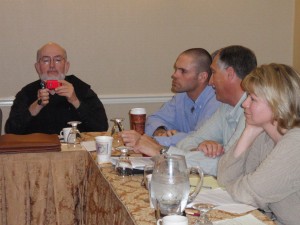
Mike McGrath, left, took photos during the roundtable
Roundtable participants applauded Mike McGrath for his upcoming retirement in June. McGrath has been the only director of Delaware’s farmland program since it began in 1991. He has overseen the preservation of 100,000 acres and headed development of program policy and administration.
The Farmland Preservation Roundtable began in 2007, meeting first in Gettysburg, and then in Lambertville, NJ. It met again in Gettysburg in 2009. No roundtable was held in 2010 due to cuts in travel budgets. The roundtable conferences are arranged by Bowers Publishing, Inc., publisher of Farmland Preservation Report.
Visit to Epcot Center changed Stonyfield CE-Yo’s perspective on agribusiness
BY BOB HEUER, Contributing Editor

Stonyfield Farm president and CEO Gary Hirshberg (Photo by channels.com)
Many local food entrepreneurs lack access to credit as well as to the financial expertise needed to create creditworthy businesses. Stonyfield Farm president and CEO Gary Hirshberg sees an even more basic problem—unrealistic expectations.
“There are a lot of idealistic, philosophically-driven entrepreneurs who are not ready to play by the rules of the commercial world,” he says. “To secure credit, you have to speak the language of investors and bankers.”
Hirshberg delivered the keynote address at the Familyfarmed EXPO’s second annual financing conference on March 17 in Chicago.

The FamilyFarmed Expo in Chicago drew 4,500 attendees and 155 exhibitors
Over the last three decades, this self-described “pathological optimist” built a seven-cow organic school in New Hampshire into a $360 million a year yogurt business.
In 1981, Hirshberg was executive director of the New Alchemy Institute, a research/education center dedicated to sustainable system design. On a visit to Disney World’s Epcot Center, he realized the Kraft-funded Land Pavilion drew about as many people on a daily basis as the institute did in a year. “It suddenly became vividly clear to me that we needed to reach beyond the limitations of our NGO audience,” he recalls. “Creating a real business would demonstrate the benefits of organic foods to much larger numbers of people.”
Hirshberg soon joined the board of a New Hampshire save-the-family-farm organization called The Rural Education Center (TREC). He and TREC founder Samuel Kaymen realized private enterprise may be an avenue to realize their “big honking goal to change the nature of a food system that makes people and the planet sick.”
In 1983, Hirshberg joined TREC full-time to launch Stonyfield Farm with a $35,000 loan from charitable sources. “We learned early that you have to keep your virtues and values in proper context. The number one goal has to be to survive so you can make a difference. You have to shelve your inviolable principles over the short term to achieve your goals in the long term. When you’re in debt with friends’ and family’s money, you don’t have time for philosophy.”
In food processing, he says: “Small is rarely beautiful. There are definite and distinct advantages to scale.”
Stonyfield buys its milk through the CROPP Cooperative which consists of 1,750 small dairy farms. (Average herd size is about 70 cows.) The processor’s seven facilities nationwide require 180,000 acres of organic production for milk purchases alone.
“This radical improvement of local farm economies couldn’t have been done without us getting big,” Hirshberg contends.
At first, the only thing big was a dream. “We tried to imagine an organic marketplace but there was no supply or demand. We had no money or networks or resources to market. All we had was an idea for delicious yogurt which in the end was really the most important thing.”
They scratched together financing from multiple sources, extending equity stakes in the company and relying on friends and family to co-sign for loans. When they outgrew the 1,500 square foot plant inside an old barn and sought a lease for a 21,000 square-foot building, the capital needs totaled exactly $592,500. “I’ll never forget the number,” Hirshberg says. “We had SBA loan guarantees but the banks would only lend us $300,000. We needed more equity.”
By the time Stonyfield became profitable, it had several hundred shareholders. In 2001, Hirshberg negotiated a deal in which he retained majority control—and will do as long as he is company president and “CE-Yo.” The global company Groupe Danone bought all non-employee investors through an arrangement that Hirshberg recommends as a way for mid-sized businesses to provide investor liquidity.
Hirshberg advises aspiring food entrepreneurs to keep their day jobs until a critical mass of consumers agrees that they have a good-tasting product currently unavailable in the market. “It’s better to spend another year working in the kitchen on R&D before putting your family at risk with a leap into business. Stonyfield Farm has been the thrill of my life but, at times, a very dangerous ride that is not for the meek.”
Bob Heuer is an Illinois-based writer and marketing consultant in the area of food, farming and agriculture policy. He produces a free e-news service called Fork to Farm and is a contributing editor of Farmland Preservation Report.
Will farmland preservation programs keep farmland affordable?
BY DEBORAH BOWERS, Editor & Publisher
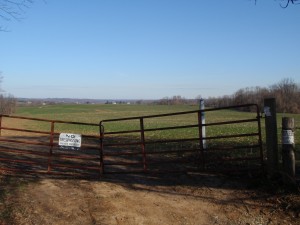
Farmland affordability ~ will farmers be locked out despite farmland preservation programs? A new study led by Rutgers looks to find out. (FPR photo)
NEW BRUNSWICK, NJ – A new study led by the Food Policy Institute at Rutgers through a USDA grant will try to determine whether farmland preservation programs are keeping land affordable for farmers, according to Brian Schilling, Food Policy Institute associate director and specialist in agricultural policy.
The study will focus on five state-level programs in three states- the state farmland program in New Jersey administered by the NJ State Agriculture Development Committee (SADC), Delaware’s state farmland program, and three programs operated in Maryland, including the farmland program operated by the Maryland Agricultural Lands Preservation Foundation (MALPF), the Rural Legacy Program and the easement donation program of the Maryland Environmental Trust, which holds easements on more than 1,000 properties, many of those on farmland.
The team will interview about 500 farmers in these states to measure their satisfaction with their respective programs, the extent to which they feel constrained by their deed of easement and their experiences in the farmland marketplace, if any. Schilling said the study will also explore the ownership patterns of preserved farmland, looking at what percent is owner-operated, what that means, and to what extent leasing plays a role in commercial production.
Schilling, who is leading a team that consists of researchers from Rutgers, University of Maryland, University of Delaware, and the University of Nebraska Center for Great Plains Studies, said the study had its genesis in 2004 when the SADC formed a farmland affordability working group.

Brian Schilling
“We knew preserved farms were increasing in value pretty significantly and the question was whether or not that appreciation was resulting in commercial farmers having less access to that land. We had taxpayer money going to funding programs so that farmland would be available for farming in perpetuity. So the question in my view was whether or not that policy goal was being met. Are preserved farmland parcels remaining affordable and accessible for farmers?”
Schilling said data at that time was lacking, and the question couldn’t be answered. “That’s when the seed was planted in my mind – we needed to understand what goes on in the market and whether there is this affordability gap.”
Data began to be collected in 2006. Working with SADC, Schilling and his team looked at data from the first farm preserved in 1985 to early 2007. Of 325 farms that were resold in arms-length market transactions, Schilling said it was “clear to us we were seeing a sharp increase in those per acre values when they were being resold.” From 2005 to 2007, just before the real estate market plunged, Schilling’s analysis of about 50 farms sold during that period showed the average value of those farms was over $10,000 per acre, close to double the average value from the period of 2000 to 2004, of about $5800 per acre.
“That per acre value was two to three times what the typical farmer could economically rationalize as a fair market value for farmland,” he said.
When states desire to assist with intergenerational transfers of small and medium size farms, the question arises, Schilling said, of whether preserving farmland would help keep land available for small and medium size farm operations? The study aims to find out if there is an affordability gap, if so, how big is it, and, what, if anything can be done about it? Schilling said he would like to put that question to a roundtable of experts including program administrators from the region.
The research team will also look at how policies that affect housing on preserved farms, such as exclusion areas, residual dwelling site opportunities (RDSO – NJ) and limitations on house size affect farmland affordability.
The New Jersey program includes a fee simple option that enables the program to purchase farms outright. The program then resells the farms with easements that include limits on the size of any new residence.
While completing landowner interviews will take longer, Schilling said he hopes a summary paper on the study’s major findings will be released this summer.
“This is such an exciting and important study – we are eager to get these findings out.”